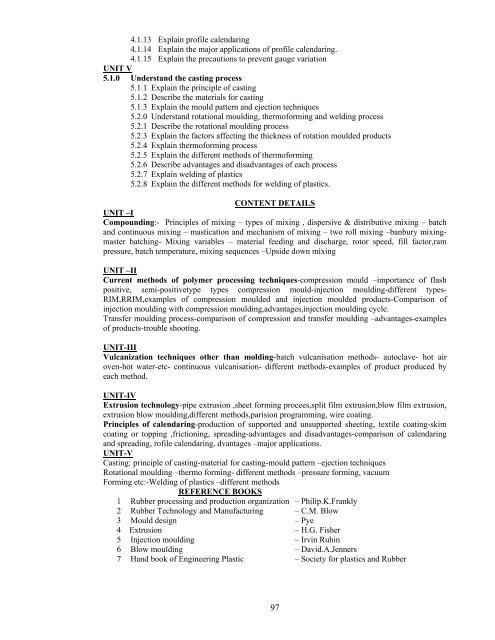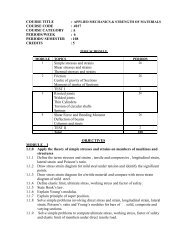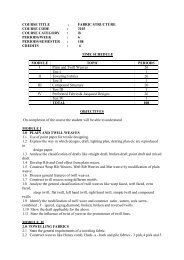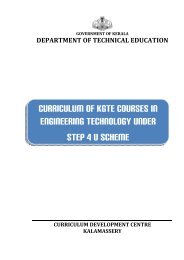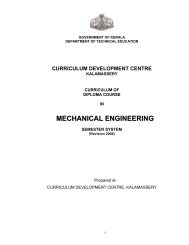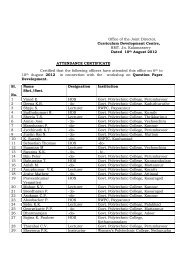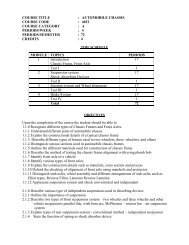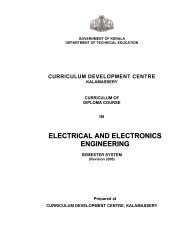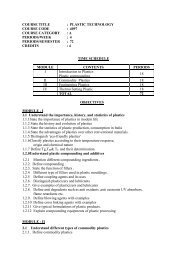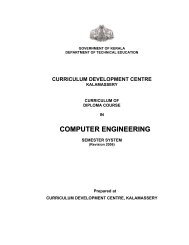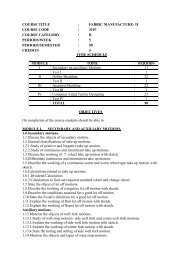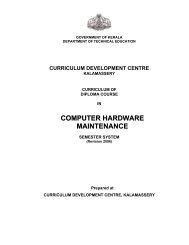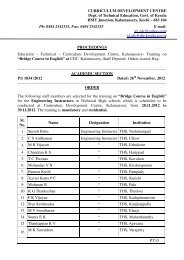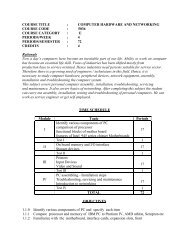23 - Curriculum Development Centre, Kalamassery
23 - Curriculum Development Centre, Kalamassery
23 - Curriculum Development Centre, Kalamassery
You also want an ePaper? Increase the reach of your titles
YUMPU automatically turns print PDFs into web optimized ePapers that Google loves.
4.1.13 Explain profile calendaring4.1.14 Explain the major applications of profile calendaring.4.1.15 Explain the precautions to prevent gauge variationUNIT V5.1.0 Understand the casting process5.1.1 Explain the principle of casting5.1.2 Describe the materials for casting5.1.3 Explain the mould pattern and ejection techniques5.2.0 Understand rotational moulding, thermoforming and welding process5.2.1 Describe the rotational moulding process5.2.3 Explain the factors affecting the thickness of rotation moulded products5.2.4 Explain thermoforming process5.2.5 Explain the different methods of thermoforming5.2.6 Describe advantages and disadvantages of each process5.2.7 Explain welding of plastics5.2.8 Explain the different methods for welding of plastics.CONTENT DETAILSUNIT –ICompounding:- Principles of mixing – types of mixing , dispersive & distributive mixing – batchand continuous mixing – mastication and mechanism of mixing – two roll mixing –banbury mixingmasterbatching- Mixing variables – material feeding and discharge, rotor speed, fill factor,rampressure, batch temperature, mixing sequences –Upside down mixingUNIT –IICurrent methods of polymer processing techniques-compression mould –importance of flashpositive, semi-positivetype types compression mould-injection moulding-different types-RIM,RRIM,examples of compression moulded and injection moulded products-Comparison ofinjection moulding with compression moulding,advantages,injection moulding cycle.Transfer moulding process-comparison of compression and transfer moulding –advantages-examplesof products-trouble shooting.UNIT-IIIVulcanization techniques other than molding-batch vulcanisation methods- autoclave- hot airoven-hot water-etc- continuous vulcanisation- different methods-examples of product produced byeach method.UNIT-IVExtrusion technology-pipe extrusion ,sheet forming procees,split film extrusion,blow film extrusion,extrusion blow moulding,different methods,parision programming, wire coating.Principles of calendaring-production of supported and unsupported sheeting, textile coating-skimcoating or topping ,frictioning, spreading-advantages and disadvantages-comparison of calendaringand spreading, rofile calendaring, dvantages –major applications.UNIT-VCasting: principle of casting-material for casting-mould pattern –ejection techniquesRotational moulding –thermo forming- different methods –pressure forming, vacuumForming etc:-Welding of plastics –different methodsREFERENCE BOOKS1 Rubber processing and production organization – Philip.K.Frankly2 Rubber Technology and Manufacturing – C.M. Blow3 Mould design – Pye4 Extrusion – H.G. Fisher5 Injection moulding – Irvin Ruhin6 Blow moulding – David.A.Jenners7 Hand book of Engineering Plastic – Society for plastics and Rubber97


